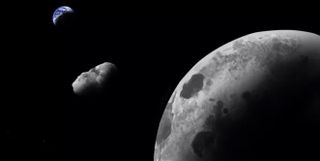China to launch Tianwen 2 asteroid-sampling mission in 2025
The mission will sample an asteroid, return to Earth and then head out again to study a second space rock.

China plans to launch its second-ever deep space exploration effort in 2025, according to the chief designer of the country's Tianwen 1 Mars mission.
Zhang Rongqiao told China Central Television on May 13 that the Tianwen 2 asteroid probe has entered the engineering development stage.
"The components are undergoing comprehensive testing," Zhang said, speaking one day before the one-year anniversary of the landing of China's Zhurong Mars rover, part of the Tianwen 1 mission. "We are moving forward as scheduled and expect to launch it in 2025."
Related: The latest news about China's space program
Tianwen 1 was a big step for China; it was the country's first fully homegrown interplanetary mission and pulled off China's first landing on another planet. But the follow up will also be complex and challenging.
The 10-year-plus Tianwen 2 mission will first target the small near-Earth asteroid Kamo'oalewa, which may actually be a blasted-off piece of Earth's moon. The spacecraft will collect samples from the space rock using a touch-and-go technique similar to those demonstrated by Japan's Hayabusa 2 and NASA's OSIRIS-Rex asteroid probes.
Tianwen 2 will also attempt an unprecedented anchor-and-attach method, using four robotic arms to land on Kamo'oalewa, with drills on the arms securing the probe to the surface of the 130-foot-wide (40 meters) asteroid.
Get the Space.com Newsletter
Breaking space news, the latest updates on rocket launches, skywatching events and more!
Tianwen 2 is expected to return to Earth more than two years after launch, dropping off its invaluable cargo. But that won't be the end of the mission. Following release of its reentry capsule, Tianwen 2 will use Earth's gravity to help propel it out toward another ancient relic of the solar system: an "active asteroid," an object with properties of both asteroids and comets. (Active asteroids used to be known as main-belt comets, but that term has lately fallen out of fashion because these bodies tend to be more asteroid-like in composition.)
The spacecraft will embark on a roughly seven-year-long voyage out to 311P/PANSTARRS. Once there, it will orbit and analyze the object using a range of cameras and spectrometers to glean insights into questions such as the mystery of the source of Earth's water.
The Space Research Institute of the Russian Academy of Sciences will also be involved in the active-asteroid phase of the mission. The institute was selected to provide particle and solar wind detectors following a 2019 call for proposals announced by the China National Space Administration (CNSA).
The mission concept has changed since early proposals were offered late in the last decade. Originally, the spacecraft would have visited the active asteroid 133P/Elst-Pizarro after its sampling phase. Selecting the second target object likely depended on when the spacecraft would launch.
The mission was also tentatively named "Zheng He" after a famous Chinese naval explorer of the early 1400s, with the name evoking historic exploration feats as China embarks on new expeditions into deep space.
Further ahead, Tianwen 3, currently scheduled for launch in 2028, will attempt to collect samples from Mars and deliver them to Earth, while Tianwen 4 will send a probe to Jupiter, according to CCTV+.
Follow us on Twitter @Spacedotcom or on Facebook.
Join our Space Forums to keep talking space on the latest missions, night sky and more! And if you have a news tip, correction or comment, let us know at: community@space.com.

Andrew is a freelance space journalist with a focus on reporting on China's rapidly growing space sector. He began writing for Space.com in 2019 and writes for SpaceNews, IEEE Spectrum, National Geographic, Sky & Telescope, New Scientist and others. Andrew first caught the space bug when, as a youngster, he saw Voyager images of other worlds in our solar system for the first time. Away from space, Andrew enjoys trail running in the forests of Finland. You can follow him on Twitter @AJ_FI.
